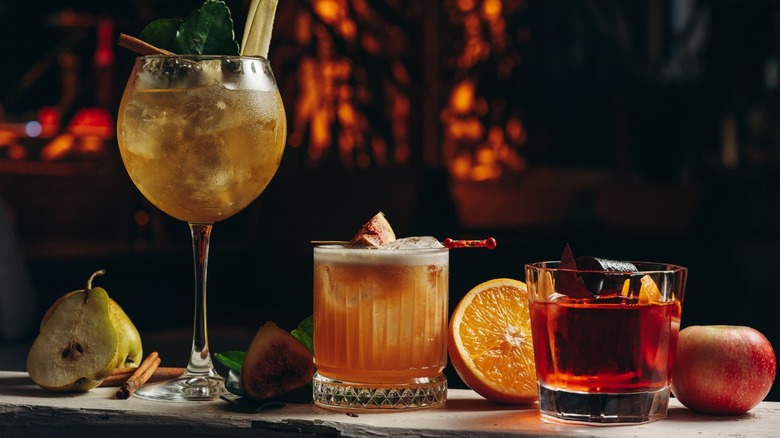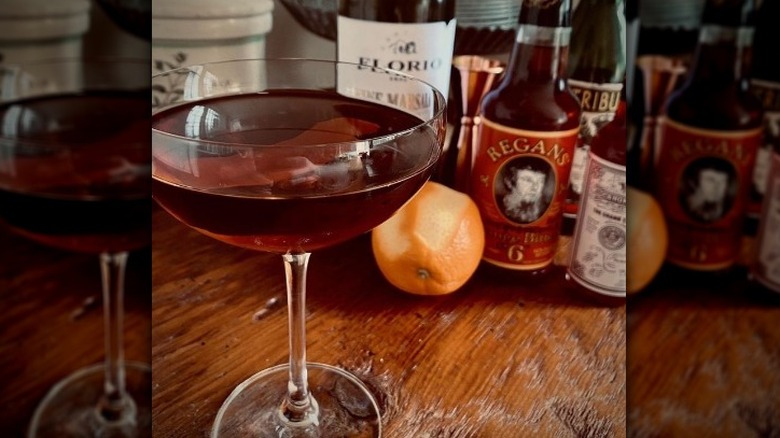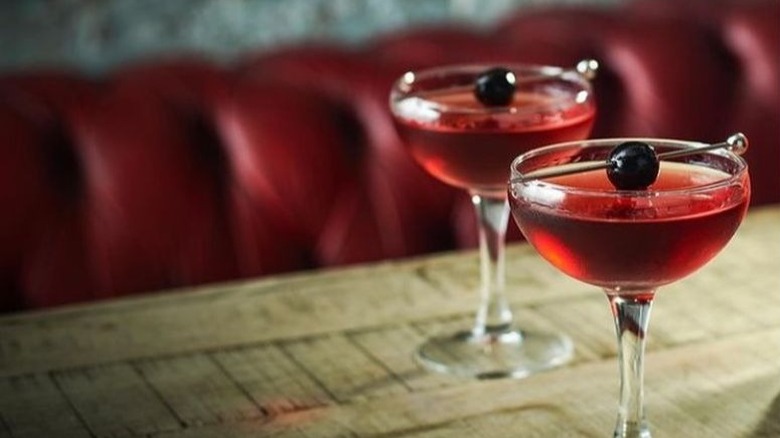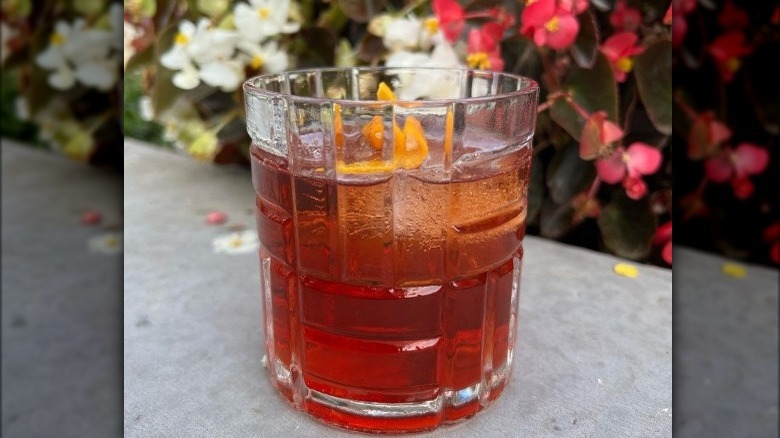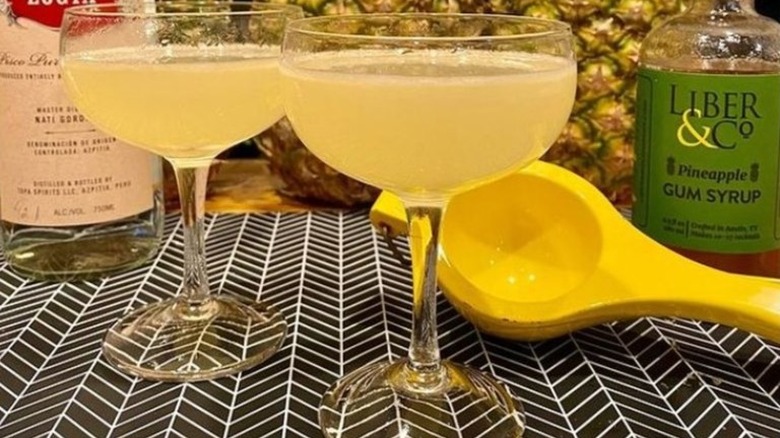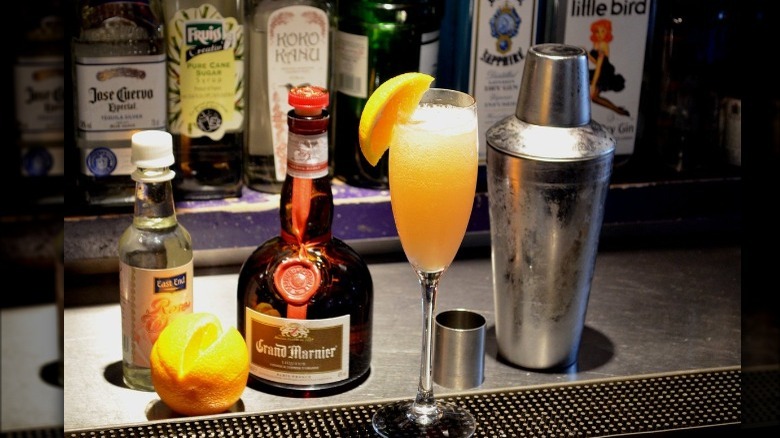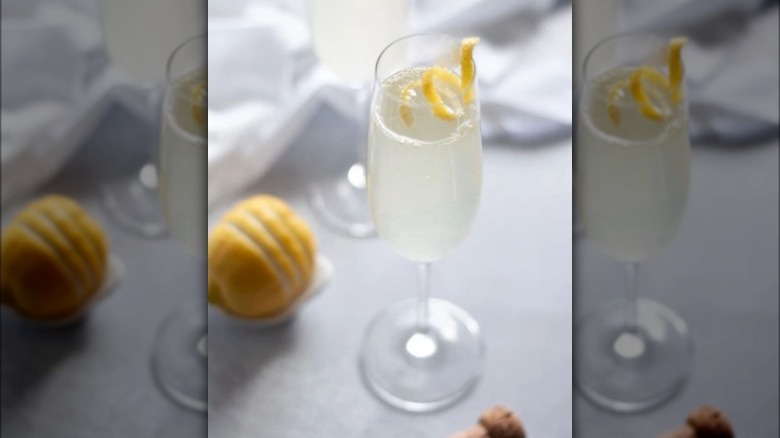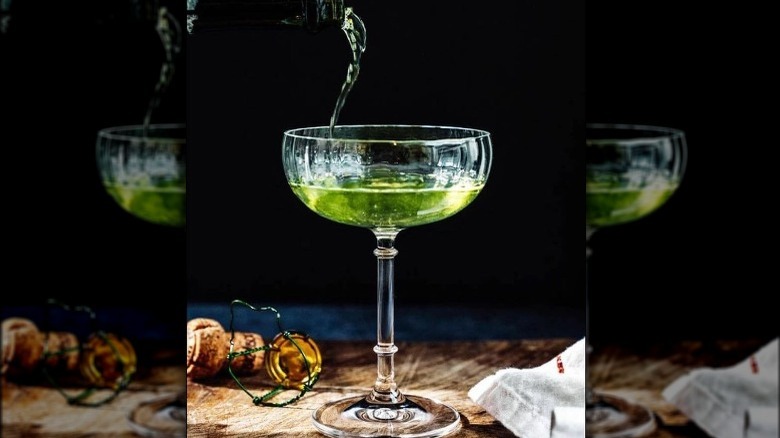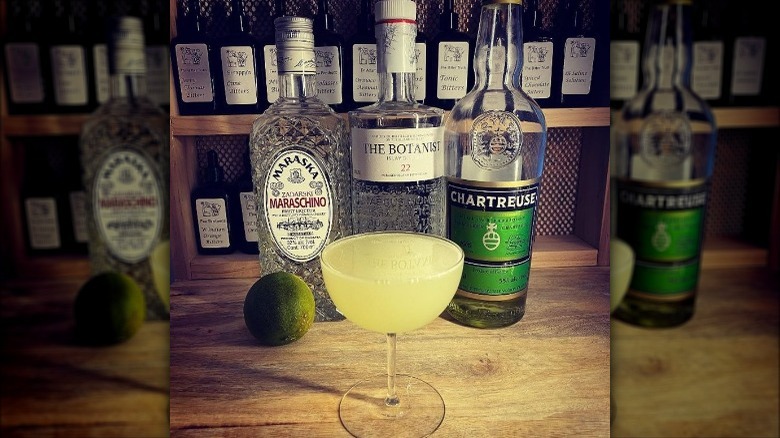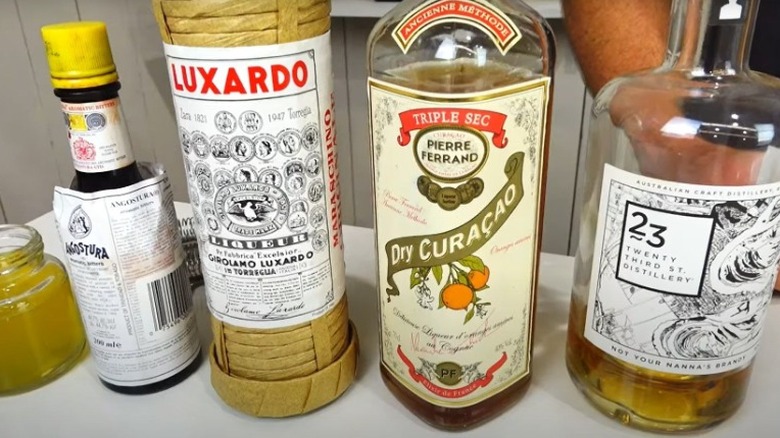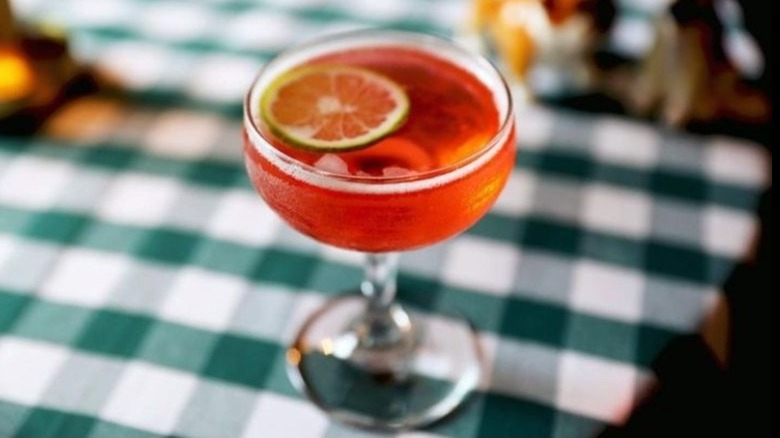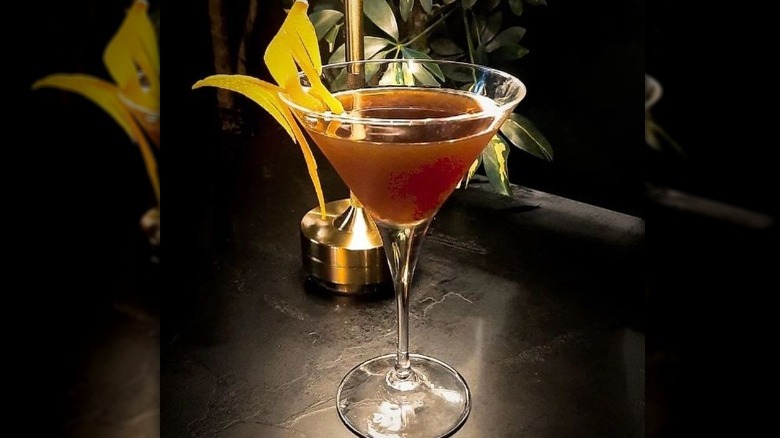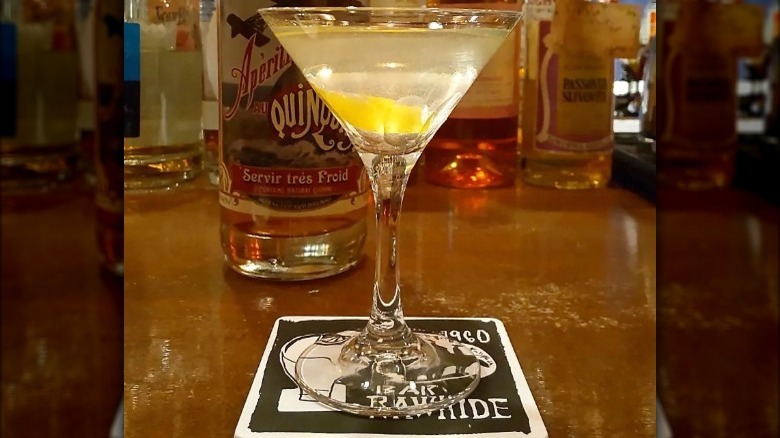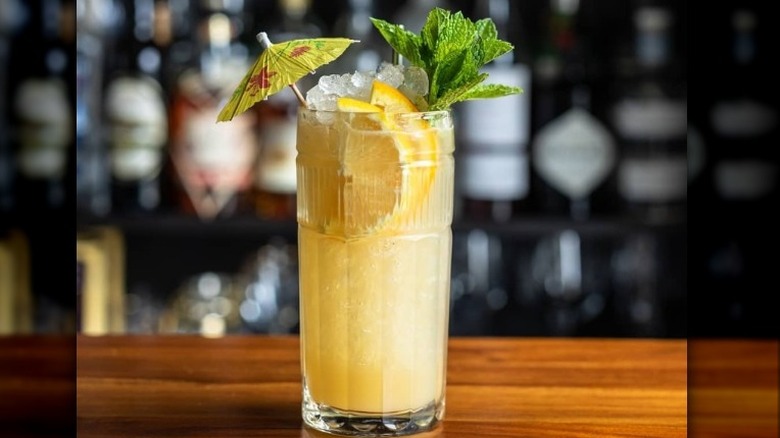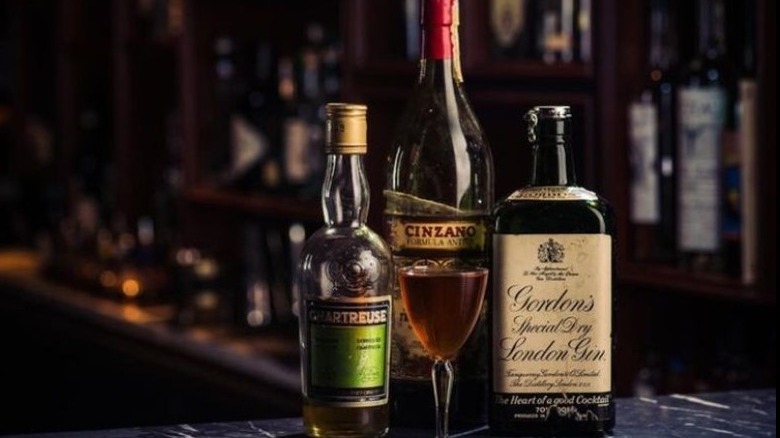15 Forgotten Cocktails You Should Order
From Mai Tais to margaritas and martinis to mojitos, there are many popular and delicious cocktails out there to try, whether you're into vodka, brandy, rum, or another spirit. For every popular drink you'll find on your local cocktail bar's menu, there are also plenty of cocktails that have, for whatever reason, been forgotten and confined to the history books.
Cocktails inspired by Hemingway, beverages named after Broadway musicals, and even tipples linked to New York gangsters: Every forgotten cocktail on our list has its own unique and interesting story to share. Some of these drinks include ingredients you won't commonly find in local stores, so rather than making them at home, head for your nearest cocktail bar and see if you can order off-menu. Next time you're at the bar, whether that's on National Cocktail Day (March 24) or any other day, why not rediscover one of these forgotten cocktails?
1. Adonis
Named after the first musical to run for over 500 performances on Broadway in the late 19th century, the Adonis is a sherry-based cocktail with sweet red vermouth and orange bitters. Though Oloroso is the sherry often recommended, this cocktail can also be made with Fino, Amontillado, or Palo Cortado sherry, or a half and half blend of two sherries, depending on your preferences.
An excellent aperitif served with olives or nuts, the Adonis has a dry finish with delicate flavors. A reviewer on Difford's Guide tried the cocktail with GB Apostoles Palo Cortado sherry and commented on its rich date and prune flavors.
If you're looking for a cocktail that's light in alcohol, this is an excellent choice at 1.8 units (depending on the sherry used), making it a great pre-dinner drink to boost your appetite. This cocktail is traditionally served in a coupe glass, with a lemon or orange twist.
2. Martinez
The Martinez can be thought of as the classic Martini's early inspiration, appearing first in O.H. Byron's "The Modern Bartender's Guide" in 1884. The origins of this tipple are unclear, but some say it was created by Jerry Thomas, a famous author and bartender, in a bar in Martinez, California
Whatever its history, this gin-based cocktail traditionally uses Old Tom Gin, which started becoming popular in the U.S. in the 1880s and has a sweeter flavor than dry gin. It also includes Punt e mes sweet vermouth, bitters, and maraschino liqueur to give it its gorgeous, deep red hue. Some recipes add orange curaçao, while others use a blend of sweet and dry vermouth.
The Martinez is best served in a chilled coupe glass, topped with a black olive, maraschino cherry, or an orange zest twist. If you're pairing this cocktail with food, its medium dry finish matches well with seafood, particularly oysters, ensuring it's an excellent drink for special occasions.
3. Boulevardier
The older, dare we say more sophisticated cousin of the Negroni, the Boulevardier uses whiskey instead of gin. This Bourbon-based cocktail also adds Campari and sweet vermouth to the mix, and is traditionally served in a rocks glass, over ice, garnished with a twist of orange.
One reviewer on Difford's Guide warns against adding too much Campari to the cocktail, as this can easily overwhelm the other flavors. Another reviewer commented, "I really like the smoky feel a Laphroaig 10 gives this."
The Boulevardier's history is almost as interesting as its complex, woody flavors. The cocktail owes its existence to Erskine Gwynne, editor of French expat magazine The Boulevardier, after which the cocktail is named. However, it didn't hit its peak of popularity until its appearance in "Barflies and Cocktails," a 1927 cocktail compendium by Harry MacElhone.
If enjoying the Boulevardier with food, it pairs well with strong cheese, smoked ham, or other bold flavors thanks to its blend of sweet, bitter, smoky flavors.
4. The New York Sour
Don't be fooled by this cocktail's name: The New York Sour, once known as the Continental Sour (and later the Claret Snap), is thought to have originated in Chicago in the late 1800s before becoming popular in NYC bars. Making its first appearance in Jerry Thomas' "Bartenders Guide" in 1862, the New York Sour is not to be confused with the Pisco Sour.
A traditional whiskey sour uses whiskey, lemon juice, and sugar; the New York Sour elevates this by using bourbon and adding a red wine float for visual appeal and a fruity, aromatic flavor. Served in a rocks glass, the red wine is poured slowly over the back of a spoon so it floats on the surface of the cocktail. An egg white is an optional addition.
If you're pairing the New York Sour with food, a delicious steak or strong cheese such as Roquefort are both great matches. Variations on the New York Sour include the Brunswick Sour, which uses rye whiskey instead of bourbon for added spiciness or the Greenwich Sour, with added bitters and egg white.
5. Pisco Punch
The Pisco Punch uses Pisco as its base. This South American brandy is made from fermented grape juice, and there are several varieties to choose from. Some recipes for the cocktail add sugar, pineapple, lemon juice, orange juice, and cloves, topping the drink with sparkling wine or champagne. Other recipes include orange bitters. Make sure you don't confuse this cocktail with the simpler Pisco Sour, which uses lime juice, sugar, and egg white.
Some claim Professor Jerry Burns is to thank for the drink's origins, serving it at the San Francisco Bank Exchange bar. However, others claim it was served earlier, on late 19th-century steamships bound for San Francisco that stopped off in Peru and Mexico.
Whatever the drink's history, Pisco Punch is traditionally served in a Collins glass or a coupe with a pineapple wedge, and its citrus flavors ensure it's the perfect match for fresh grilled fish or seafood. It's particularly good with ceviche, a lime-marinated seafood.
6. Moonwalk
Our next cocktail has one of the wildest histories around. On July 20, 1969, Neil Armstrong and Buzz Aldrin became the first men to walk on the surface of the moon, and the Moonwalk was created in memory of the Apollo 11 landing. Made by Joe Gilmore at The American Bar, the cocktail includes a sugar cube soaked in orange flower water and grapefruit bitters, topped with Grand Marnier and sparkling wine or champagne.
The story goes that Gilmore sent the cocktail to NASA in a flask, and it was the first drink the astronauts had on their return to Earth. Today, if you visit the Savoy Hotel in London, you can see the thank you letter sent from Armstrong to Gilmore on display to your left as you enter The American Bar.
This fruity, floral cocktail works well with brunch as an alternative to a mimosa or Bellini, and is usually served in a flute, garnished with an orange slice. Some recipes swap the orange flower water for rose water, instead.
7. French 75
The French 75 is a vintage cocktail that's recently made a comeback. Its simple, refreshing and tart combination of gin, lemon juice, sugar, and champagne, makes it an excellent aperitif. Though it was once served in a coupe and later a Collins glass, today you're more likely to find it in a flute, garnished with a twist of lemon.
This is another cocktail with a murky history. Though it was first spotted during Prohibition in 1927 in "Here's How!" and later featured in "The Savoy Cocktail Book" in 1930, its origins may in fact date back to the late 1880s, when author Charles Dickens served a similar drink to entertain his literary friends while visiting Boston.
Whatever the French 75's true origins, its name comes from the 75-millimeter field gun that was used by the French during the World War I. Though today its base is gin, earlier versions of the drink used cognac instead, with some adding grenadine to the mix.
8. Death in the Afternoon
Death in the Afternoon is an unusually-named cocktail created by none other than Ernest Hemingway himself, for the 1935 "So Red The Nose," or "Breath in the Afternoon" cocktail book. The cocktail takes its name from Hemingway's 1932 non-fiction book about Spanish bullfighting, and Sterling North, author of "So Red The Nose" describes its high-alcohol content: "It takes a man with hair on his chest to drink five Absinthe and Champagne cocktails and still handle the English language in the Hemingway fashion."
Made with Absinthe, simple syrup, and champagne or sparkling wine, and served in a flute or coupe, this simple yet sophisticated cocktail is an excellent match for a long, lazy weekend brunch. Its floral notes also ensure it pairs well with seafood.
One reviewer on Difford's Guide recommends using the best Champagne possible to make this cocktail. Another suggests leaving out the sugar and using Moscato d'Asti, a sweet sparkling wine, instead of Champagne.
9. The Last Word
Chartreuse fans will adore The Last Word, made with gin, chartreuse, Maraschino liqueur, and lime juice. Served straight up in a coupe glass, and traditionally garnished with a maraschino cherry, The Last Word's tangy, fruity flavors are sure to be an instant hit with those who love Chartreuse.
One reviewer on Difford's Guide mentioned that Bardinet Maraschino seemed to overwhelm other flavors in the cocktail. Others commented that Luxardo was the best brand of Maraschino liqueur to use in The Last Word.
First spotted in 1915, right before Prohibition began, at the Detroit Athletics Club, some credit the creation of The Last Word to bartender Frank Fogarty. Though the traditional version uses gin, other variations swap it out for bourbon or mezcal.
An excellent digestif to enjoy after a meal, The Last Word also works well with a cheese board. It's a great match for milder cheeses, such as brie or goat's cheese, in particular.
10. East India
The East India cocktail dates back to the late 19th century, and seems to have first been mentioned in Harry Johnson's "New and Improved Bartender's Manual" in 1882. Taking its name from the East India Company, it's a smooth, sweet blend of cognac, red curaçao, raspberry syrup, Maraschino liqueur, and bitters.
Another version, which came later, called East India No. 2, uses orange curaçao instead. Since red curaçao can be hard to find and the cocktail bar you're visiting may not stock it, you can turn to the East India No. 2 as a decent alternative, though it's very different in both flavor and appearance.
The deep red color and warming, fruity flavors of the East India ensures it's an excellent winter warmer, best enjoyed in front of an open fire on a chilly night. Its rich flavors and brandy base also make it the perfect pairing for strong cheese, venison, or dark chocolate. This cocktail is usually served in a coupe glass, garnished with a twist of lemon or orange zest.
11. Jack Rose
If a cocktail linked to a New York gangster tickles your fancy, the Jack Rose is the drink for you. This cocktail's origins are unclear, but some claim it was the favorite drink of late 19th-century New York gangster and informant "Bald" Jack Rose, from whom the tipple takes its name. The Jack Rose also seems to have been popular among literary circles, showing up in the novel "The Sun Also Rises" (Hemingway, 1926), and was said to be the drink of choice for John Steinbeck.
The Jack Rose is a tasty blend of Applejack apple brandy (or Calvados), grenadine, and lemon juice. The drink was first spotted in print in "Jack's Manual" in 1908, though this early version used lemon and orange juice, raspberry syrup, and fizzy water.
Some recipes add lime juice, raspberry syrup, orange bitters, and even egg white. Whichever way it's made, the Jack Rose is generally served in a coupe with a lemon wedge. An excellent aperitif to whet your appetite, it's also delicious with a dessert of fruit pie or tart, allowing its fruity flavors to shine through.
12. The Hanky Panky
Female bartenders were a rarity in the 1920s, and this next cocktail was invented by Ada "Coley" Coleman, one of the few females tending bar in 1921. The story goes that Coleman created this cocktail for the actor Sir Charles Hawtrey while working at The American Bar in London's Savoy Hotel. Upon finishing his drink, he exclaimed, "By Jove, this is the real hanky panky!" giving the cocktail its name.
The Hanky Panky is definitely an acquired taste, as this gin-based cocktail uses the bitter Italian digestif Fernet Branca, along with sweet vermouth. One commenter on Difford's Guide described it best by saying, "This is a polarizing cocktail." Some recipes suggest adding orange juice to cut through the bitterness.
Typically served in a Nick and Nora glass with a twist of orange zest, the Hanky Panky's bitterness cuts through rich foods. It's an especially good match for roast turkey with all the trimmings, but pairs equally well with roast pork or other meats.
13. Vesper
Ordering the Vesper when you walk into a bar is sure to make you feel like 007. After all, it was Bond's drink of choice, created and first introduced in 1953 in author Ian Fleming's first Bond book, "Casino Royale." The Vesper's name is inspired by fictional character and Bond Girl Vesper Lynd.
Some claim the Vesper showed up earlier, in "World's Drinks And How To Mix Them" (1934). However, the cocktail in question, also called a Vesper, bears no resemblance to the modern dry martini.
Shaken, not stirred, with dry gin, vodka, and Lillet Blanc, the Vesper is a world away from other martinis. Most martinis use dry vermouth, where this cocktail opts for aromatized wine, providing simultaneously sweet and bitter flavors. Served in a classic martini glass, the Vesper is generally garnished with a twist of lemon zest, and makes an excellent choice for an aperitif.
14. Fog Cutter
The Fog Cutter is a cocktail not to be taken lightly. It packs a triple alcoholic punch thanks to its potent blend of white rum, gin, brandy, sour mix, and simple syrup. Some recipes substitute Pisco, orange juice, and lemon juice for the sour mix, while others add a float of sherry or Appleton rum to the top of the drink.
Created in the 1940s by legendary San Francisco bar tender Trader Vic (Victor Bergeron), the man who also created the Mai Tai, the Fog Cutter is mentioned in his "Bartender's Guide". The entry from Vic reads, "Fog Cutter, hell. After two of these you won't even see the stuff."
This classic Tiki cocktail is packed with tropical fruity flavors and hints of sweet almond. A delicious summer drink for hot days, it's usually served long over ice and presented in a Collins glass with a garnish of mint — and perhaps a cocktail umbrella.
15. Bijou
In French, the word "Bijou" means "jewel" and some would say this cocktail is a gem among chartreuse concoctions. With the aforementioned colorful green chartreuse, sweet vermouth, dry gin, and just a dash of orange bitters, it's a bit of an acquired taste, heavily herbaceous and sweet, which may not be for everyone. For those who aren't fans of the herbaceous notes, extra gin can be added, with the vermouth and chartreuse reduced, to create a drier finish.
The history of the Bijou cocktail is a little murky, though it's thought to have been created by Harry Johnson, a bartender who included it in his "Bartender's Manual" in 1900. That's about as much as we know about the drink's heritage, though.
The Bijou is generally served in a Nick and Nora glass or a coupe, garnished with a twist of lemon zest. A Maraschino cherry on a skewer is also a popular way to serve this cocktail.
